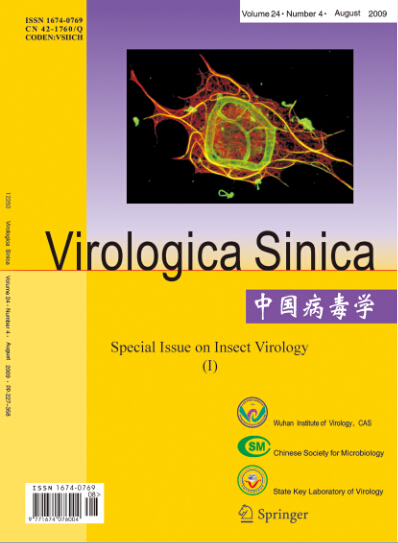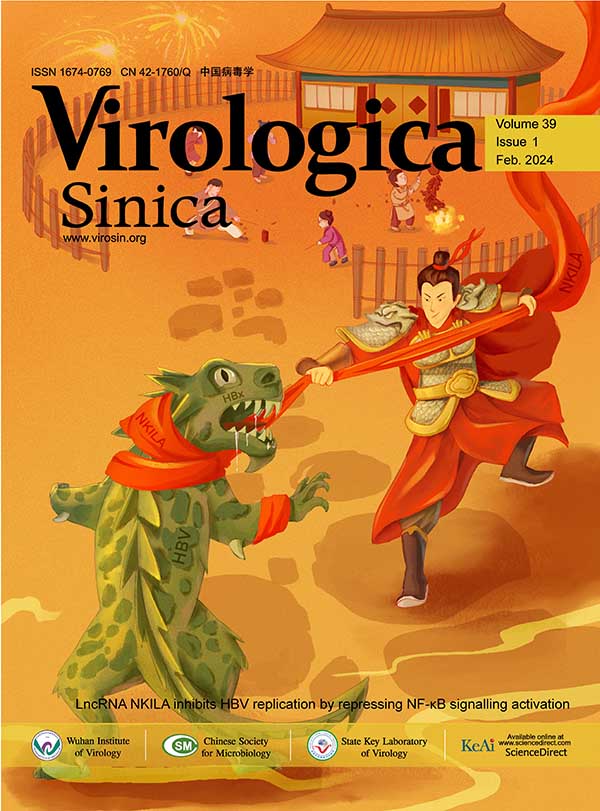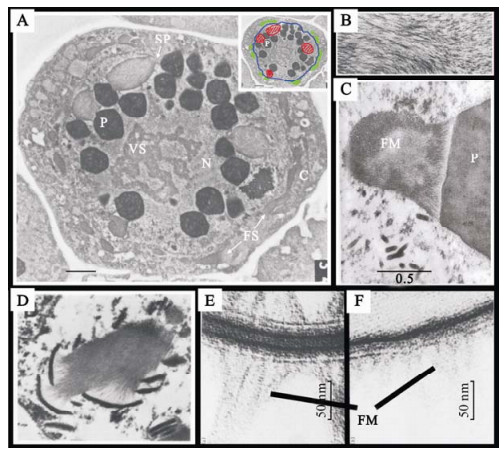
The Long Road to Understanding the Baculovirus P10 Protein
2009, 24(4): 227 doi: 10.1007/s12250-009-3045-0
The baculovirus P10 protein has always represented a mystery in the field of insect virology. Like the baculovirus polyhedrin protein it is expressed at high levels very late in infection. Homologues of the Autographa californica nucleopolyhedrovirus p10 gene are conserved in all Alphabaculoviruses and in other viruses of lepidopteran hosts yet is completely dispensable for virus replication and transmission. P10 is a microtubule interacting protein whose expression has been associated with the formation of a variety of complex and extensive cytoplasmic and nuclear structures. P10 has been associated with a number of roles during infection ranging from the formation of virus occlusion bodies, to affecting the rate of cellular and/or nuclear lysis during the final stages of the virus replication cycle. In this article we review recent work aimed at understanding the role of this enigmatic protein, putting them into context with recent advances in understanding of protein structure and function. We look back at a number of historical studies and observations, reanalysing their conclusions based on recent data and our own observations. The role of the P10 protein during baculovirus replication remains elusive, however, novel avenues of investigation have been identified that will, we are sure, eventually lead to an understanding of this protein.
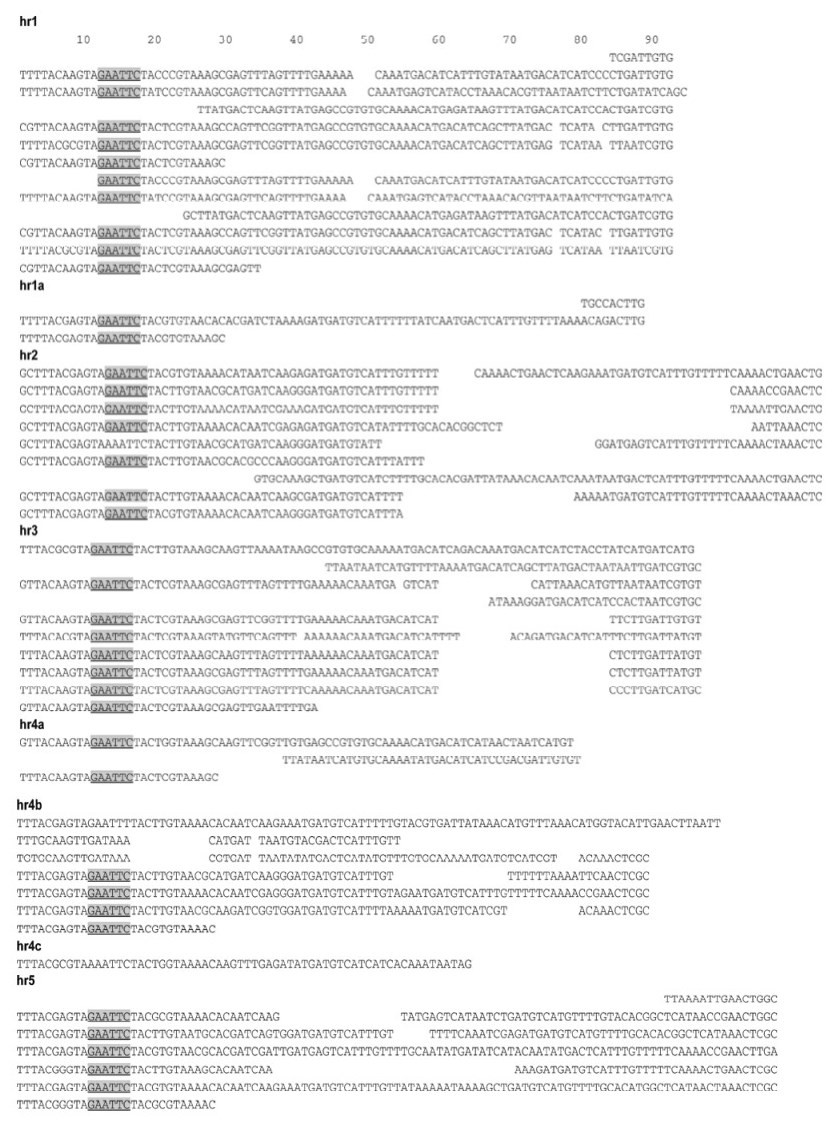
AcMNPV As A Model for Baculovirus DNA Replication*
2009, 24(4): 243 doi: 10.1007/s12250-009-3047-y
Baculoviruses were first identified as insect-specific pathogens, and it was this specificity that lead to their use as safe, target specific biological pesticides. For the past 30 years, AcMNPV has served as the subject of intense basic molecular research into the baculovirus infectious cycle including the interaction of the virus with a continuous insect cell line derived from Spodoptera frugiperda. The studies on baculoviruese have led to an in-depth understanding of the physical organization of the viral genomes including many complete genomic sequences, the time course of gene expression, and the application of this basic research to the use of baculoviruses not only as insecticides, but also as a universal eukaryotic protein expression system, and a potential vector in gene therapy. A great deal has also been discovered about the viral genes required for the replication of the baculovirus genome, while much remains to be learned about the mechanism of viral DNA replication. This report outlines the current knowledge of the factors involved in baculovirus DNA replication, using data on AcMNPV as a model for most members of the Baculoviridae.

Virion Proteomics of Large DNA Viruses*
2009, 24(4): 268 doi: 10.1007/s12250-009-3062-z
Large DNA viruses normally have complex structures with many of protein components derived from both viral and host origins. The development in proteomics, especially mass spectrometry identification techniques provide powerful tools for analyzing large viruses. In this review, we have summarized the recent achievements on proteomic studies of large DNA viruses, such as herpesvirus, poxvirus, nimavirus and baculoviruse. The proteomics of baculovirus occlusion-derived virions (ODV) were emphasized. Different mass spectrometry techniques used on various baculoviruses were introduced, and the identified structurally associated proteins of baculoviruses are summarized.
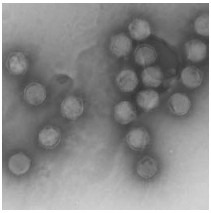
The Biology of Chilo Iridescent Virus
2009, 24(4): 285 doi: 10.1007/s12250-009-3051-2
Chilo iridescent virus (CIV) is the type species for genus Iridovirus, and belongs to the family Iridoviridae. Since the discovery of CIV in 1966, many attempts were made to elucidate the viral genome structure. The virions contain a single linear ds DNA molecule that is circularly permuted and terminally redundant. The genome of CIV has been entirely sequenced. The CIV virion consists of an unusual three-layer structure containing an outer proteinaceous capsid, an intermediate lipid membrane, and a core DNA–protein complex containing the genome. CIV has a broad host spectrum and has, in general, a limited mortality effect on its hosts. Up to now there have been several studies about CIV describing its structure, ecology, and molecular biology. In this review study we present all these studies together to describe the CIV.

Invertebrate Iridovirus Modulation of Apoptosis*
2009, 24(4): 295 doi: 10.1007/s12250-009-3060-1
Programmed cell death (apoptosis) is a key host response to virus infection. Viruses that can modulate host apoptotic responses are likely to gain important opportunities for transmission. Here we review recent studies that demonstrate that particles of Invertebrate iridescent virus 6 (IIV-6) (Iridoviridae, genus Iridovirus), or an IIV-6 virion protein extract, are capable of inducing apoptosis in lepidopteran and coleopteran cells, at concentrations 1000-fold lower than that required to shut-off host macromolecular synthesis. Induction of apoptosis depends on endocytosis of one or more heat-sensitive virion component(s). Studies with a JNK inhibitor (SP600125) indicated that the JNK signaling pathway is significantly involved in apoptosis in IIV-6 infections of Choristoneura fumiferana cells. The genome of IIV-6 codes for an inhibitor of apoptosis iap gene (193R) that encodes a protein of 208 aa with 15% identity and 28% similarity in its amino acid sequence to IAP-3 from Cydia pomonella ganulovirus (CpGV). Transcription of IIV-6 iap did not require prior DNA or protein synthesis, indicating that it is an immediate-early class gene. Transient expression and gene knockdown studies have confirmed the functional nature of the IIV-6 iap gene. We present a tentative model for IIV-6 induction and inhibition of apoptosis in insect cells and discuss the potential applications of these findings in insect pest control.
The Parasitoid Factor in the Virulence and Spread of
Lepidopteran Baculoviruses
2009, 24(4): 305 doi: 10.1007/s12250-009-3049-9
Insect parasitoids and baculoviruses play important roles in the natural and strategic biological control of insects. The two parasites are frequent competitors within common hosts and much research has focused on the negative impact that baculoviral host infections have on parasitoids. This review summarizes the impacts that parasitoids may have on the virulence and spread of lepidopteran baculoviruses. By changing host behavior and development, parasitoids have been shown to decrease baculovirus virulence and productivity within parasitized baculovirus-susceptible hosts; however, studies of the tools used by hymenopteran parasitoids to overcome their hosts’immune systems, suggest that parasitoids may, in some cases, facilitate baculoviral infections in less susceptible hosts. Laboratory and field research have demonstrated that parasitoids can mechanically transmit baculoviruses between insects, and in this way, increase the efficacy of the viruses. Instances of new, more virulent isolates of baculoviruses have been recorded from specifically parasitoid-targeted hosts suggesting other possible benefits from the transmission or activation of baculoviruses by parasitoids.
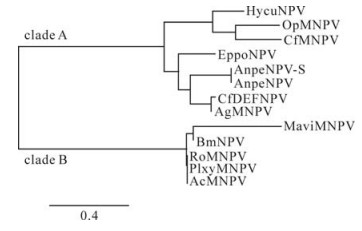
Molecular Dissection of Bombyx mori Nucleopolyhedrovirus orf8 Gene
2009, 24(4): 315 doi: 10.1007/s12250-009-3054-z
Viruses including baculoviruses are obligatory parasites, as their genomes do not encode all the proteins required for replication. Therefore, viruses have evolved to exploit the behavior and the physiology of their hosts and often coevolved with their hosts over millions of years. Recent comparative analyses of complete genome sequences of baculoviruses revealed the patterns of gene acquisitions and losses that have occurred during baculovirus evolution. In addition, knowledge of virus genes has also provided understanding of the mechanism of baculovirus infection including replication, species-specific virulence and host range. The Bm8 gene of Bombyx mori nucleopolyhedrovirus (NPV) and its homologues are found only in group I NPV genomes. The Autographa californica NPV Ac16 gene is a homologue of Bm8 and, encodes a viral structural protein. It has been shown that Bm8/Ac16 interacts with baculoviral and cellular proteins. Bm8/Ac16 interacts with baculoviral IE1 that is facilitated by coiled coil domains, and the interaction with IE1 is important for Bm8 function. Ac16 also forms a complex with viral FP25 and cellular actin and associates with membranes via palmitoylation. These data suggested that this gene family encodes a multifunctional protein that accomplishes specific needs of group I NPVs.
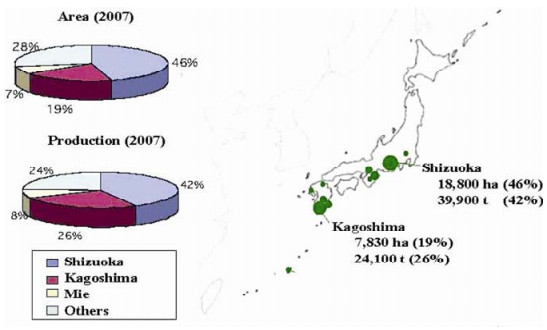
Biological Control of Tortricidae in Tea Fields in Japan Using Insect
Viruses and Parasitoids*
2009, 24(4): 323 doi: 10.1007/s12250-009-3057-9
Tea is a perennial and evergreen plant. Cultivated tea trees provide a habitat for insect pests and their natural enemies. In Japan, granuloviruses (GVs) have successfully controlled two of the most important pests of tea, Adoxophyes honmai and Homona magnanima (Tortricidae: Lepidoptera). The GVs are produced in vivo and a single application sustains pesticidal efficacy throughout a year, which encompasses 4 to 5 discrete generations of both species. A. honmai and H. magnanima also have various natural enemies, especially hymenopteran parasitoids. Such resident natural enemies also play a role in reducing the pest density in virus-controlled fields, but the effect of virus infection on parasitoids sharing the same host larva has not been well studied. Survival of one of the major parasitoids of A. honmai, Ascogaster reticulata (Braconidae: Hymenoptera), is reduced by virus infection of the host. Viruses, including GV and entomopoxvirus (EPV), and certain koinobiont endoparasitoids, including A. reticulata, are both known to regulate host endocrinology. However, the GV and EPV have distinct host regulation mechanisms, and consequently have different impacts on the survival of A. retuculata, when A. reticulata parasitizes a host that is infected with either GV or EPV. These additional effects on host regulation displayed by both viruses and parasitoids affect the outcome of virus-parasitoid interactions.

Involvement of Lipid Rafts and Cellular Actin in AcMNPV GP64
Distribution and Virus Budding*
2009, 24(4): 333 doi: 10.1007/s12250-009-3055-y
GP64 is the major envelope glycoprotein associated with the budded virus (BV) of Autographa californica nucleopolyhedrovirus (AcMNPV) and is essential for attachment and budding of BV particles. Confocal microscopy and flotation assays established the presence of lipid raft domains within the plasma membranes of AcMNPV-infected Sf9 cells and suggested the association of GP64 with lipid rafts during infection. GP64 and filamentous actin (F-actin) were found to co-localise at the cell cortex at 24 and 48 hpi and an additional restructuring of F-actin during infection was visualised, resulting in a strongly polarised distribution of both F-actin and GP64 at the cell cortex. Depletion of F-actin, achieved by treatment of Sf9 cells with latrunculin B (LB), resulted in the redistribution of GP64 with significant cytoplasmic aggregation and reduced presence at the plasma membrane. Treatment with LB also resulted in reduced production of BV in Sf9 cells. Analysis of virus gene transcription confirmed this reduction was not due to decreased trafficking of nucleocapsids to the nucleus or to decreased production of infectious progeny nucleocapsids. Reduced BV production due to a lack of GP64 at the plasma membrane of AcMNPV-infected Sf9 cells treated with LB, suggests a key role for F-actin in the egress of BV.
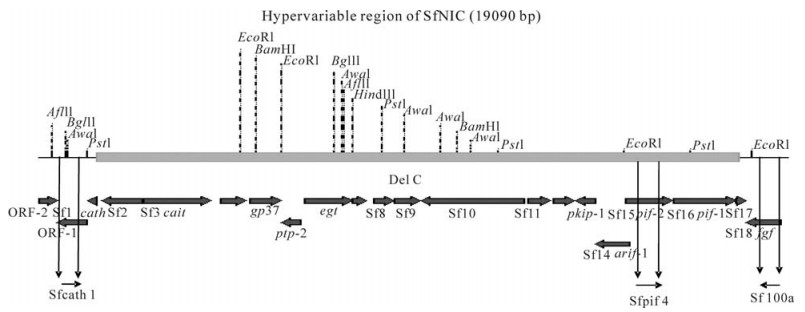
Entry into Midgut Epithelial Cells is a Key Step in the Selection of Genotypes in a Nucleopolyhedrovirus*
2009, 24(4): 350 doi: 10.1007/s12250-009-3048-x
An isolate of the Spodoptera frugiperda multiple nucleopolyhedrovirus comprises a stable proportion of deletion genotypes (e.g., SfNIC-C), that lack pif1 and pif2 rendering them noninfectious per os, and that survive by complementation with a complete genotype (SfNIC-B) in coinfected cells. To determine whether selection for particular ratios of complete and deletion genotypes occurs mainly during the establishment of the primary infection in insect midgut cells or during subsequent systemic infection, we examined genotype frequencies in insects that fed on OBs comprising different co-occluded mixtures of genotypes. Dramatic changes in genotype frequencies were observed between the OB inoculum and budded virus (BV) samples taken from larvae inoculated with OBs comprising 10% SfNIC-B + 90% SfNIC-C indicating that a marked reduction of SfNIC-C genotype had occurred in the insect midgut due to the immediate elimination of all OBs that originated from cells that had been infected only by SfNIC-C. In contrast, immediate changes were not observed in OBs comprising mixtures of 50% SfNIC-B + 50% SfNIC-C or those comprising 10% SfNIC-B + 90% SfNIC-C as most of the OBs in these mixtures originated from cells that had been infected by both genotypes. Subsequent changes in genotypic frequencies during five days of systemic infection were fairly small in magnitude for all genotypic mixtures. We conclude that the prevalence of defective genotypes in the SfNIC population is likely determined by a balance between host selection against OBs produced in cells infected by SfNIC-C alone and within-host selection for fast-replicating deletion genotypes. The strength of intra-host selection is likely modulated by changes in MOI during the infection period.
- [01/11]《中国病毒学(英文)》期刊编辑部招聘启事
- [05/07]Q1区!VS最新影响因子5.5!
- [22/02]2022年VS高被引论文奖发布
- [21/10]第十届新生病毒性疾病控制学术研讨会 | 第一轮通知
- [09/09]肝癌细胞中CK1α上调IFNAR1的表达,从而促进I型IFN抑制HBV复制
- [09/09]一种新的干扰素诱导的长非编码RNA ZAP-IT1阻断寨卡病毒在A549细胞中的复制
- [09/09]首发精神分裂症中,驯化的人内源性逆转录病毒W家族包膜蛋白通过降低5-HT4受体的水平激活SK2
- [09/09]发热伴血小板减少综合征病毒L蛋白功能域和保守残基研究为理解病毒RNA转录/复制机制提供新思路
- [09/09]亲环素A结合AKT1并通过介导AKT/mTOR/NF-κB正反馈环路的激活促进EB病毒的致瘤作用 | VS推荐
- [09/09]转录组分析显示克里米亚刚果出血热病毒调控的关键细胞过程及III型干扰素的抗病毒作用 | VS推荐







